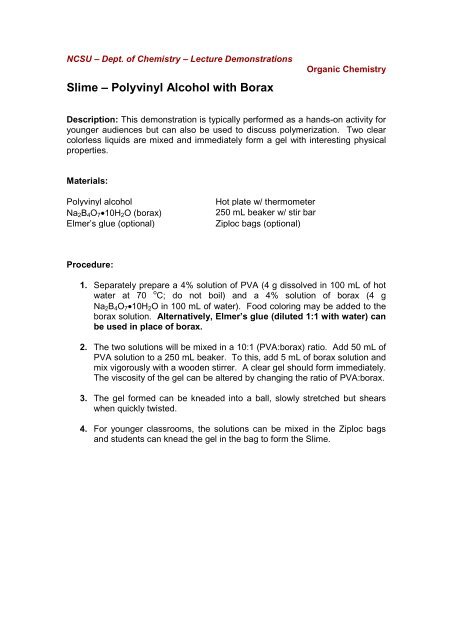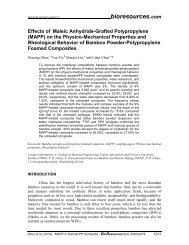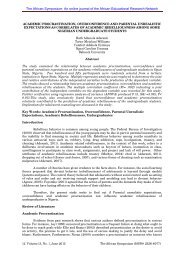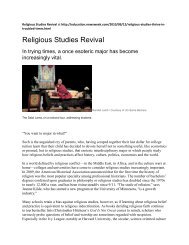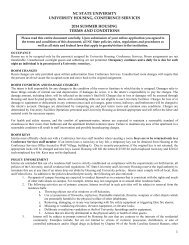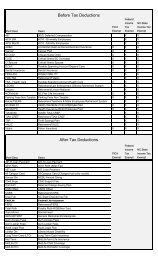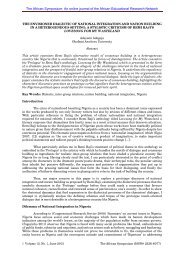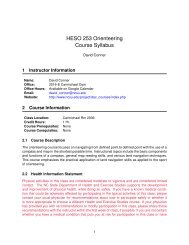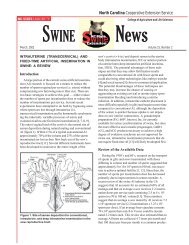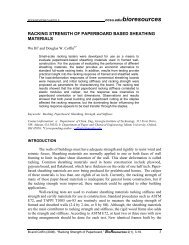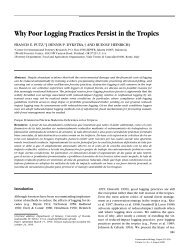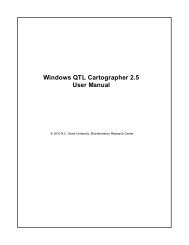You also want an ePaper? Increase the reach of your titles
YUMPU automatically turns print PDFs into web optimized ePapers that Google loves.
NCSU <strong>–</strong> Dept. of Chemistry <strong>–</strong> Lecture Demonstrations<br />
<strong>Slime</strong> <strong>–</strong> <strong>Polyvinyl</strong> <strong>Alcohol</strong> <strong>with</strong> <strong>Borax</strong><br />
Organic Chemistry<br />
Description: This demonstration is typically performed as a hands-on activity for<br />
younger audiences but can also be used to discuss polymerization. Two clear<br />
colorless liquids are mixed and immediately form a gel <strong>with</strong> interesting physical<br />
properties.<br />
Materials:<br />
<strong>Polyvinyl</strong> alcohol Hot plate w/ thermometer<br />
Na2B4O7•10H2O (borax) 250 mL beaker w/ stir bar<br />
Elmer’s glue (optional) Ziploc bags (optional)<br />
Procedure:<br />
1. Separately prepare a 4% solution of PVA (4 g dissolved in 100 mL of hot<br />
water at 70 o C; do not boil) and a 4% solution of borax (4 g<br />
Na2B4O7•10H2O in 100 mL of water). Food coloring may be added to the<br />
borax solution. Alternatively, Elmer’s glue (diluted 1:1 <strong>with</strong> water) can<br />
be used in place of borax.<br />
2. The two solutions will be mixed in a 10:1 (PVA:borax) ratio. Add 50 mL of<br />
PVA solution to a 250 mL beaker. To this, add 5 mL of borax solution and<br />
mix vigorously <strong>with</strong> a wooden stirrer. A clear gel should form immediately.<br />
The viscosity of the gel can be altered by changing the ratio of PVA:borax.<br />
3. The gel formed can be kneaded into a ball, slowly stretched but shears<br />
when quickly twisted.<br />
4. For younger classrooms, the solutions can be mixed in the Ziploc bags<br />
and students can knead the gel in the bag to form the <strong>Slime</strong>.
NCSU <strong>–</strong> Dept. of Chemistry <strong>–</strong> Lecture Demonstrations<br />
Organic Chemistry<br />
Discussion: The borate ion in solution serves as a cross linking agent for PVA<br />
generating a new polymeric structure. Na2B4O7 hydrolyzes in solution to<br />
generate B(OH)4 - . This reacts <strong>with</strong> the <strong>–</strong>OH groups on PVA to generate a<br />
structure as shown below:<br />
OH OH<br />
OH OH<br />
n<br />
n<br />
+ B(OH) 4 -<br />
O<br />
B<br />
O<br />
n<br />
+ 4 H2O O O<br />
Safety: Be sure to inform younger audiences that materials are not to be<br />
ingested.<br />
Disposal: Gel can be disposed of in normal waste.<br />
References:<br />
Shakhashiri, B. Z. In Chemical Demonstrations: A Handbook for Teachers of<br />
Chemistry; The University of Wisconsin Press: 1989; Vol. 3, p 362-363.<br />
Katz, D. A. J. Chem. Educ. 1994, 71, 891.<br />
McLaughlin, K. W.; Wyffels, N. K.; Jentz, A. B.; Keenan, M. V. J. Chem. Educ.<br />
1997, 74, 97.<br />
JCE Editorial Staff J. Chem. Educ. 1998, 75, 1432A.<br />
Video: http://www.youtube.com/watch?v=emlW5Jh-AHc (Gluep)<br />
n


